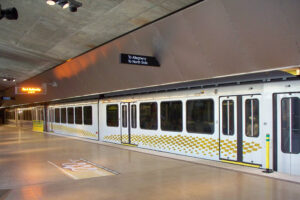Bus and light-rail ridership on Pittsburgh Regional Transit (PRT) routes remains far below pre-pandemic levels. Compared with September 2019, average daily ridership was 29.3 percent lower in September 2023.
Ridership data are provided by PRT’s performance metrics and system tool which shows ridership by route. In September 2023, PRT operated 96 bus routes and three light-rail routes. Bus ridership was down 28.2 percent while light-rail ridership was down 38.2 percent.
Average ridership on the routes ranged from 1.3 percent above to 83.2 percent below the four-year-earlier level. Compared to September 2019, for the 98 routes that had lower ridership, six were 10 percent or less below, 66 routes ranged from 11 to 49 percent below and 26 routes were 50 percent or more below. In September 2019, the highest average ridership was on the Red Line light-rail route at 22,983; four years later ridership was 14,952, or 34.9 percent lower, but the route still ranked highest in terms of average ridership.
The 10 worst-performing routes, where ridership was down in the range from 73.8 percent to 83.2 percent, were primarily what PRT classifies as “commuter,” (routes that connect major job centers). The continued hybrid work-from-home arrangements is likely the main reason for the declines in ridership. The table below shows average ridership for these 10 routes in the month of September from 2019 to 2023.
PRT September Route Performance, 2019 to 2023
Measured from the September 2019 average ridership baseline, successive September months through the pandemic had lower ridership of 63 percent, 43 percent, 33 percent and the 29 percent reported this year.
Last year we called on the providers of subsidies to reevaluate their financial support in order to get PRT to make significant changes to service, fleet and personnel (PRT’s most recent adjustment to trip frequency and stops went into effect Oct. 1).
PRT approved its $535 million budget for fiscal year (FY) 2023-24 this past June with subsidies from federal, state, Allegheny County and the Regional Asset District (RAD) sources.
As a match for state operating and capital assistance, the county’s 2024 budget includes $47.7 million from alcoholic beverage taxes and vehicle rental taxes to PRT (up from $41.9 million in this year’s budget). RAD’s preliminary budget includes a $3 million grant from sales and use- tax revenue for PRT (the same amount each year since 2013, with the exception of the COVID- affected 2021). Both budgets are currently being considered for approval.
In short, nothing has changed and it is possible more may be asked for in the coming years.
The Pennsylvania Auditor General’s Office recent performance audit of PRT, which covered July 1, 2019, through June 30, 2022, noted PRT intends to use the balance of its federal COVID aid (PRT received $502 million in total) by the end of FY 2023-24. PRT’s deferred revenue reserves—which, according to the audit, are realized when “revenues and subsidies exceed expenditures” and those dollars can remain deferred with no time limitation before they are used—will run out in FY 2027-28.
The audit stated “if there is no increase in passenger revenue or other funding sources … PRT will have to make difficult decisions regarding the services provided, including the possibility of reducing available times and routes.” In the audit period, PRT reduced service by 25 percent across-the-board from March through September 2020.
The financial scenario presented in the audit could lead to a massive service reduction that would anger riders who, in turn, will push policymakers to find money to avoid the cuts. So which funding sources come to the rescue? More state operating assistance? Allegheny County with new taxing powers?
In agreeing with the audit’s findings on finances, PRT noted it is working on “strategies that potentially could provide long-term funding solutions” while it “will continue to explore cost-cutting solutions in every facet of its business.”
The better option is the latter and to start the long-overdue adjustment to PRT operations rather than turning to taxpayers. Most importantly, however, would be eliminating the right of transit workers to strike when there is a bargaining impasse.


